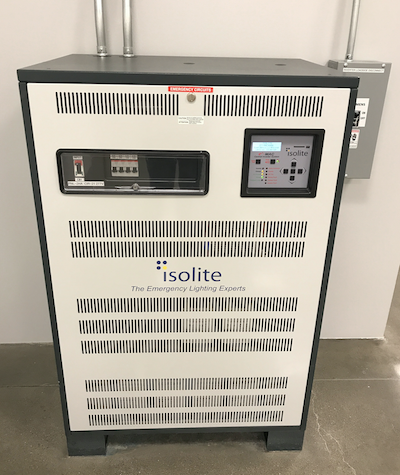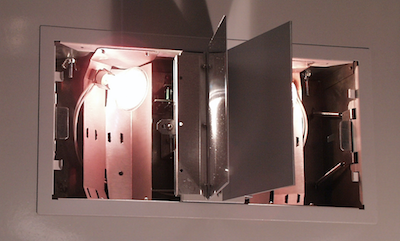Single-source emergency lighting solutions
From lights to exit signs, a single-source emergency lighting system product supplier can streamline the design process for electrical engineers.
 |
| Isolite's energy-efficient LED edge-lit exit signs use less than 3 watts and offer a 3-hour emergency run time with a battery diagnostic monitoring system. |
 |
| Selecting inverters that provide pure sine wave AC power, operate at their designated rating and provide automated testing/reporting are the factors that should be considered in making a final inverter selection best suited for the application. |
 |
| One manufacturer of specification-grade emergency lighting products, Isolite, offers the Genie, along with a more compact version called the Mini Genie, that remain fully recessed behind two flat panel doors until required. |
For electrical engineers responsible for designing a building’s emergency lighting system, the process of selecting and integrating the various component parts from lights to exit signs is not a one-size-fits-all proposition.
After all, there are a myriad of combinations and approaches available that will sufficiently provide one foot candle of illumination along the path of egress specified by the NFPA.
These options often begin with deciding on the type of power source that will be used in the event of a power outage. Often, existing architectural lights are incorporated if possible, powered by centralized inverters or generators. However, when that is not sufficient, dedicated battery powered emergency lights may be required.
In an industry flooded with inexpensive, commoditized products, another key decision is whether to specify higher end, architectural alternatives.
Dedicated emergency lights, for example, can be concealed until needed behind panels that can be covered by wallpaper or matching wall paint, if desired. Even emergency exit signs require consideration, with options ranging from inexpensive thermoplastic models to more elegant, energy efficient models.
Additional challenges can occur within the design and specification process as well.
Although electrical engineers are well trained in emergency lighting system design, it is often one of the last aspects considered. This can create difficulties sourcing and receiving items – often from multiple parties.
However, for those emergency lighting product companies that provide a full catalogue of options from lights to exit signs and inverters, much of the pain can be taken out of the process by simplifying the interaction and providing a single source.
“Electrical engineers prefer not to source items from three different companies: one for the exit sign, one for the inverter, and another for the lighting,” says Bill Lynch, President of Isolite Corporation, a company that offers high quality, specification grade emergency lighting products.
Design-Conscious Emergency Lights
Dedicated emergency lighting is often utilitarian, obtrusive and unsightly. One of the most common, low cost options involves two lamps and a bulky battery pack that is often referred to as a “bug-eye” light.
Fortunately, more stylish options exist. At the top of the list is incorporating existing architectural lighting into the emergency lighting plan. In this approach, the architectural lights operate as normal. If utility power is lost, however, supplemental power can be supplied via an inverter or generator.
While this approach is ideal, there are many situations in which the existing lighting will not provide the requisite illumination along the entire path. When this occurs, lighting designers often seek out more high-end, stylish fixtures. Even items such as bug-eyes and exit signs are available in more aesthetic versions.
When emergency lighting is necessary, one of the most aesthetic options is actually to conceal it until it is required. Some ingenious units are even designed to blend in with the existing decor by being painted or covered with wallpaper.
For example, one manufacturer of specification-grade emergency lighting products, Isolite, offers the Genie, along with a more compact version called the Mini Genie, that remain fully recessed behind two flat panel doors until required.
“If power is lost, the battery-powered units automatically open to light the way,” explains Lynch.
Exit Signs
Although exit signs must be functional, they do not need to be ugly. A variety of aesthetic options exist including slim profiles, specialty finishes, and recessed power supplies that help units blend in with interior decor and architectural features.
Because exit signs operate 24/7, however, they should also be energy efficient. As such, some energy efficient LED edge-lit exit signs use less than 3 watts and offer a 3-hour emergency run time with a battery diagnostic monitoring system.
Today, new “dual technology” exit signs are even combining the efficiency of LED lighting with revolutionary new photoluminescent materials to increase reliability and performance over decades of use.
This hybrid approach combines two established exit sign technologies in a single unit – LED and photoluminescence. During normal power conditions, the sign is illuminated with highly efficient LEDs. When the power goes out, a translucent exit stencil diffusor made of photoluminescent material provides the illumination. This is charged by the LEDs while electric power is provided to the sign.
“Although LED technology has improved to the point where it can last over 20 years, battery technology has not kept pace and has been the weak point in exit sign reliability and maintenance,” says Lynch. “Hybrid LED/photoluminescent technology eliminates this weakness and provides more reliable operation for decades.”
Inverters
When a building-wide power outage occurs, electrical engineers have several options when it comes to powering emergency lighting systems mandated by the NFPA and International Building Code (IBC).
The first is to install dedicated lighting fixtures that provide temporary power from built-in battery packs. The other is to utilize centrally located inverters tied to back-up batteries that can provide utility-grade power to both existing architectural and dedicated emergency lighting in the event of a power outage.
For engineers that must select an inverter, calculating the size needed as well as AC load requirements is a relatively simple matter.
However, there are multiple factors that should also be considered in making a final inverter selection that best suits the application. These include selecting inverters that provide pure sine wave AC power, operate at their designated rating, and provide automated testing/reporting.
Given the increasing use of LEDs in architectural lighting, it is important to select an inverter that incorporates pure sine wave technology.
Pure sine wave inverters provide cleaner, utility grade power than modified sine wave models and work better with LED drivers. In addition, pure sine wave models have a high surge capacity which means they are able to exceed their rated wattage for a limited time to meet the high inrush currents of LEDs.
“When utility power is lost and the current influx from LED fixtures is drawn from an inverter, most standard inverters are not able to handle the inrush even when they are rated for the total rated load,” says Lynch.
To accommodate such challenges, the company offers a variety of units. This includes units incorporating pure sine wave technology as well as units that can be sized to meet full building load requirements for power up to 18,000 watts.
In order to meet safety and regulatory requirements for emergency lighting, one of the most important capabilities of advanced inverters is the ability to automate testing and reporting functions.
NFPA code requires that emergency lighting systems are tested for 10 minutes every 30 days, and to be discharged for 90 minutes once annually. Records must be kept for review by Fire Marshalls or other officials that make periodic inspections of emergency lighting systems.
The more advanced inverter systems keep a record of all of that information. A Fire Marshall can simply review the logs and see the testing was automatically performed as scheduled as well as see any alarms.
The inverters can also be controlled through a unique web interface that allows a facility manager to monitor multiple inverters at the same time as well as set alarms and automatic notifications. The system also conducts and records data related to the regular monthly tests required by code.
“When electrical engineers face tight deadlines to design emergency lighting systems so a building or facility can be opened for use, partnering with a vendor that offers comprehensive options can streamline the process,” concludes Lynch. “In this regard, some domestic manufacturers can provide a fully integrated system with as little as two weeks of lead time.”
For more information, contact Isolite Corporation at 31 Waterloo Avenue, Berwyn, PA 19312; call 800-888-5483; or visit them on the web at www.isolite.com
















